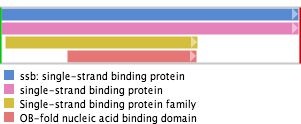Rv0054 - single-strand binding protein ssb

|
|
Protein Domains  |
| Gene Information | |
|---|---|
| Locus | Rv0054 |
| Symbol | ssb |
| Gene Name | single-strand binding protein ssb |
| Location | 58586 - 59080 (+) |
| Species | Mycobacterium tuberculosis H37Rv complete genome. |
| Length | Gene:495 bp Protein:165 aa |
| External Links | Tuberculist Target Gene Information String Protein-Protein Interactions STITCH Chemical-Protein Interactions Search Google Scholar |
Orthologs

|
| Orthogroup Number | 36997 |
| Related Genes | CE2819 cg3307 DIP2290 jk2065 MAP0068 Mkms_5458 ML2684 Mmcs_5369 MSMEG_6896 MT0060 MUL_0072 Mvan_6033 nfa55730 | Transcriptional Regulation |
| Operons | View gene in operon browser |
| Regulatory Network | |
| Expression Correlation |
Genes with Correlated Expression Scatterplot of Gene Expression |